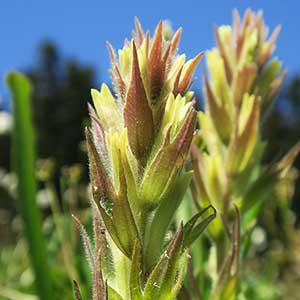Castilleja cryptantha
Castilleja occidentalis
Mt. Rainier or obscure paintbrush, obscure Indian paintbrush, obscure paintbrush
western Indian paintbrush, western or western yellow paintbrush, western paintbrush
few to several, erect or ascending, unbranched, hairs spreading, long, soft, eglandular, mixed with short stipitate-glandular ones.
several to many, erect or ascending, usually short-decumbent at base, unbranched, sometimes glabrous proximally, hairs spreading, long, soft, mixed with medium length to short stipitate-glandular ones only in inflorescence.
green, often with brown or purple veins, narrowly to broadly lanceolate, 1.5–4 cm, not fleshy, margins plane, ± involute, 0–3-lobed, apex acute to acuminate;
lobes spreading-ascending, narrowly lanceolate, apex acute to ± obtuse.
green to deep purple, linear-lanceolate to broadly lanceolate (to linear on sterile shoots), 1.5–4(–5.5) cm, not fleshy, margins plane, flat, prominently veined, 0–3(–5)-lobed, apex acute to rounded;
lobes ascending, lanceolate, apex acute.
(2.5–)3–6 × 1–2 cm; green to dull brown or dull reddish purple throughout, or proximally green to dull brown or dull reddish purple, distally yellow on apices, broadly lanceolate to ovate, (0–)3-lobed;
lobes ascending, narrowly lanceolate, long or short, arising near mid length, apex acute or acuminate.
2–7(–10) × 1–3.5 cm;
bracts greenish to pale greenish yellow throughout, often aging dull reddish brown or reddish purple proximally, rarely dull reddish brown throughout, or proximally green, dull reddish brown, or reddish purple, distally greenish white, yellow, or cream, broadly lanceolate to widely oblong to ovate, 0–3(–7)-lobed;
lobes ascending, triangular to lanceolate, medium length, usually arising at or above mid length, rarely just below, central lobe apex obtuse to rounded, others acute.
straight, 14–16 mm;
tube 11–14 mm;
whole corolla included within calyx;
beak adaxially pale yellow, 1–2 mm;
abaxial lip deep green, slightly inflated, 4–5 mm, 67% as long as beak;
teeth ascending, pale, 1.5–2 mm.
straight, 16–25 mm;
tube 9–15 mm;
teeth and part of abaxial lip sometimes exserted, beak exserted;
beak adaxially green, (2.5–)5–9 mm;
abaxial lip green, reduced, often visible through abaxial cleft, slightly pouched, 1.5–3 mm, 25–50% as long as beak;
teeth incurved to ascending, white, sometimes green, 0.7–2 mm.
proximally green or pale with green veins, lobes yellow, sometimes becoming deep red with age, 12–15 mm;
abaxial and adaxial clefts 3–7 mm, 25–50% of calyx length, deeper than laterals, lateral 1–3(–4) mm, 8–20% of calyx length;
lobes triangular, adaxial segments longer than abaxials, apex acute or obtuse.
proximally green to purple, distally colored as bracts, 12–20 mm;
abaxial and adaxial clefts 5–9(–10) mm, 40–50% of calyx length, deeper than laterals, lateral 1–3(–4.5) mm, 5–20% of calyx length;
lobes lanceolate to triangular, apex acute, obtuse, or rounded.
= 24.
= 24, 48.
Castilleja cryptantha
Castilleja occidentalis
Castilleja cryptantha is endemic to the vicinity of Mt. Rainier in the Cascade Range, with most populations found within Mt. Rainier National Park. Unlike most species of Castilleja, it is apparently self-pollinating (W. J. Duffield 1972); the small flowers are entirely enclosed within the yellowish calyces, which tend to grow deep reddish as they age. The purplish brown bracts are also unusual in the genus.
(Discussion copyrighted by Flora of North America; reprinted with permission.)
Castilleja occidentalis has a wide distribution in the southern Rocky Mountains, a gap in its distribution in Wyoming, and reappears in Montana and the Canadian Rockies. Bract lobing and color vary considerably but without correlation to geography. Although C. occidentalis resembles an alpine form of C. septentrionalis, C. occidentalis is missing in several regions in the distribution of the latter, even when extensive areas of suitable habitat are available, and has a discrete range.
(Discussion copyrighted by Flora of North America; reprinted with permission.)


